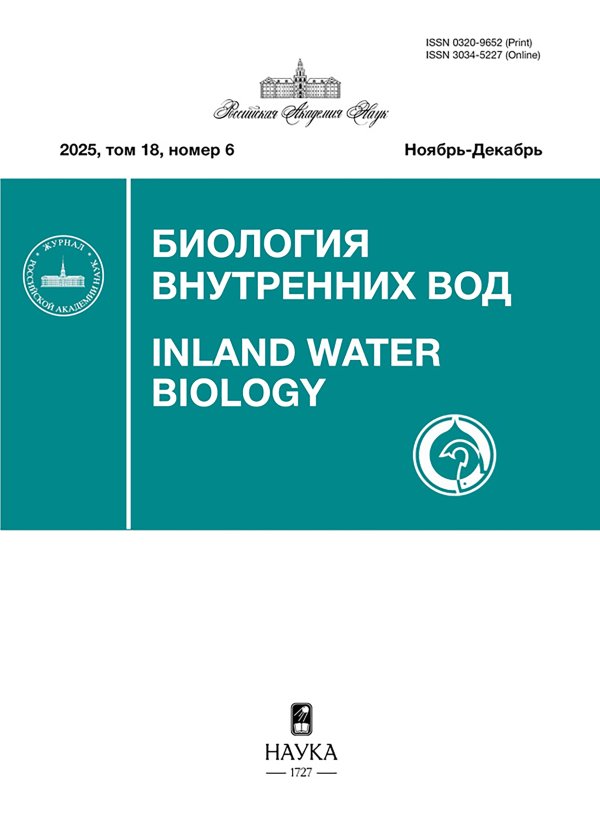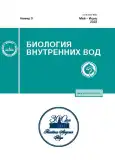Diatom Assemblages in the Sediment Traps in Lake Onega
- Authors: Ludikova A.V.1
-
Affiliations:
- Institute of Limnology of the Russian Academy of Sciences – Federal Research Center of the Russian Academy of Sciences
- Issue: No 3 (2023)
- Pages: 301-312
- Section: ВОДНАЯ ФЛОРА И ФАУНА
- URL: https://journals.rcsi.science/0320-9652/article/view/134915
- DOI: https://doi.org/10.31857/S0320965223030142
- EDN: https://elibrary.ru/PNDJJG
- ID: 134915
Cite item
Full Text
Abstract
The paper presents the first study of the composition and structure of the diatom assemblages from sediment traps installed in different parts of Lake Onega. 171 species and intraspecific diatom taxa were observed belonging to 59 genera. The predominance of planktonic diatoms is favored by large depths of the lake and a small area of the littoral zone. Aulacoseira islandica and A. subarctica, the most abundant species in spring phytoplankton in Lake Onega dominate in the sediment-traps diatom assemblages. In the sites subject to anthropogenic eutrophication, Aulacoseira ambigua is numerous as well. In a number of sites Lindavia radiosa and Pantocsekiella tripartita are among the subdominating species, while P. schumannii, Stephanodiscus neoastraea and Stephanodiscus sp. are less common. Higher proportions of periphytic Tabellaria fenestrata were recorded in the sites with the largest areas colonized by macrophytes. In all sampling sites, neutrophilous oligo-mesotrophic and oligo-hypereutrophic taxa prevail in the diatom assemblages. The predominance of two or three species in the diatom assemblage results in low values of the floristic diversity index. More diverse diatom assemblages were found in rathers isolated bays. Concentrations of diatom valves and chrysophyte cysts in sediment traps material were also calculated.
Keywords
About the authors
A. V. Ludikova
Institute of Limnology of the Russian Academy of Sciences – Federal Research Center of the Russian Academy of Sciences
Author for correspondence.
Email: ellerbeckia@yandex.ru
Russia, St. Petersburg
References
- Вислоух С.М., Кольбе Р.Р. 1927. Материалы по диатомовым Онежского и Лососинского озер // Тр. Онеж. науч. экспед. Ч. 5 (Ботаника). Вып. 1.
- Вислянская И.Г. 1999. Структура и динамика биомассы фитопланктона // Онежское озеро. Экологические проблемы. Петрозаводск. С. 146.
- Волошко Л.Н. 2016. Золотистые водоросли (Chrysophyta) водоемов северо-запада России. Разнообразие стоматоцист // Ботан. журн. Т. 101. № 11. С. 1257.
- Генкал С.И. 1996. О морфологической изменчивости диатомовой водоросли Aulacoseira subarctica (O. Müller) Haworth // Эколого-физиологические исследования водорослей и их значение для оценки состояния природных вод. Ярославль: без изд-ва С. 19.
- Генкал С.И., Трифонова И.С. 2009. Диатомовые водоросли планктона Ладожского озера и водоемов его бассейна. Рыбинск: Рыбинский Дом печати.
- Генкал С.И., Чекрыжева Т.А., Комулайнен С.Ф. 2015. Диатомовые водоросли водоемов и водотоков Карелии. М.: Науч. мир.
- Давыдова Н.Н. 1968. Состав и условия формирования диатомовых комплексов в поверхностном слое донных отложений Ладожского озера // Растительные ресурсы Ладожского озера. Л.: Наука. С. 131.
- Давыдова Н.Н. 1971. Диатомовые водоросли в поверхностном слое донных отложений Онежского озера // Растительный мир Онежского озера. Л.: Наука. С. 140.
- Давыдова Н.Н. 1975. Диатомеи донных отложений литоральной зоны Онежского озера // Литоральная зона Онежского озера. Л.: Наука. С. 192.
- Давыдова Н.Н. 1976. Комплексы диатомей в донных отложениях Онежского озера. // Палеолимнология Онежского озера. Л.: Наука. С. 130.
- Давыдова Н.Н. 1985. Диатомовые водоросли – индикаторы природных условий водоемов в голоцене. Л.: Наука.
- Ладожское озеро и достопримечательности его побережья. Атлас. 2015. Санкт-Петербург: Нестор-История.
- Лудикова А.В., Кузнецов Д.Д. 2021. Кремнистые микроводоросли в донных отложениях Ладожского озера и их роль в палеолимнологических реконструкциях // Изв. Рус. географ. об-ва. Т. 153. № 6. С. 46.
- Онежское озеро. Атлас. 2010. Петрозаводск: Карельск. науч. центр РАН.
- Петрова Н.А. 1968. Фитопланктон Ладожского озера // Растительные ресурсы Ладожского озера. Ленинград: Изд-во Ленинград. гос. ун-та. С. 73.
- Петрова Н.А. 1971. Фитопланктон Онежского озера // Растительный мир Онежского озера. Л.: Наука. С. 88.
- Петрова Н.А. 1975. Фитопланктон литоральной зоны Онежского озера // Литоральная зона Онежского озера. Л.: Наука. С. 138.
- Петрова Н.А. 1990. Сукцессия фитопланктона при антропогенном эвтрофировании озер. Л.: Наука.
- Рычкова М.А. 1971. Некоторые данные о перифитоне Онежского озера // Растительный мир Онежского озера. Л.: Наука. С. 130.
- Рычкова М.А. 1975. Перифитон литоральной зоны Онежского озера // Литоральная зона Онежского озера. Ленинград: Наука. С. 123.
- Страховенко В.Д., Белкина Н.А., Ефременко Н.А. и др. 2022. Первые данные по минералогии и геохимии взвеси Онежского озера // Геология и геофизика. Т. 63. № 1. С. 68. https://doi.org/10.15372/ GiG2020198 (Strakhovenko V.D., Belkina N.A., Efremenko N.A. et al. 2022. The First Data on the Mineralogy and Geochemistry of the Suspension of Lake Onego // Russian Geology and Geophysics. V. 63. № 1. Р. 55).https://doi.org/10.2113/RGG20204280
- Теканова Е.В., Сярки М.Т. 2015. Особенности фенологии первично-продукционного процесса в пелагиали Онежского озера // Изв. РАН. Сер. биол. № 6. С. 645.
- Тимакова Т.М., Куликова Т.П., Литвинова И.А. и др. 2014. Изменение биоценозов Кондопожской губы Онежского озера под влиянием сточных вод целлюлозно-бумажного комбината // Вод. ресурсы. Т. 41. № 1. С. 74.
- Чекрыжева Т.А. 2008. Фитопланктон как компонент биоресурсной базы озера // Биоресурсы Онежского озера. Петрозаводск: Карельск. науч. центр РАН. С. 24.
- Чекрыжева Т.А. 2012. Таксономическая и экологическая характеристика фитопланктона Онежского озера // Тр. Карельск. науч. центра РАН. № 1. С. 56.
- Чекрыжева Т.А. 2015. Диатомовые водоросли в планктоне Онежского озера // Тр. Карельск. науч. центра РАН. № 4. С. 110. https://doi.org/10.17076/bg10
- Battarbee R.W., Carvalho L., Jones V.J. et al. 2001. Diatoms // Tracking environmental change using lake sediments. V. 3. Terrestrial, algal and siliceous indicators. Dordrecht: Kluwer Acad. Publ. P. 155.
- Bennion H. 1995. Surface-sediment diatom assemblages in shallow, artificial, enriched ponds, and implication for reconstructing trophic status // Diatom Res. V. 10. P. 1.
- Davydova N.N., Kalmykov M., Sandman O. et al. 1993. Recent paleolomnology of Kondopoga Bay, Lake Onega, reflecting pollution by a large palp mill // Verh. Internat. Verein. Limnol. V. 25. P. 1086.
- Elner J.K., Happey-Wood C.M. 1978. Diatom and chrysophycean cyst profiles in sediment cores from two linked but contrasting Welsh lakes // Brit. Phycol. J. V. 13. P. 341. https://doi.org/10.1080/00071617800650411
- Gibson Ch.E., Anderson N.J., Haworth E.Y. 2003. Aulacoseira subarctica: taxonomy, physiology, ecology and palaeoecology // Eur. J. Phycol. V. 38. P. 83. https://doi.org/10.1080/0967026031000094102
- Guiry M.D., Guiry G.M. 2022. AlgaeBase. World-wide electronic publication, National University of Ireland, Galway. https://www.algaebase.org searched on 6 May 2022.
- Juggins S. 2007. C2 Vesrion 1.5 User guide. Software for ecological and palaeoecological data analysis and visualisation. Newcastle upon Tyne: Newcastle Univ.
- Krammer K., Lange-Bertalot H. 1986–1991. Bacillariophyceae // Süßwasserflora von Mitteleuropa. Stuttgart: Gustav Fisher. Bd 2/1–4.
- Ludikova A.V. 2021. Long-term studies of surface-sediment diatom assemblages in assessing the ecological state of Lake Ladoga, the largest European lake // Geogr. Environ. Sustain. V. 14. № 1. P. 251. https://doi.org/10.24057/2071-9388-2020-174
- Ludikova A.V., Belkina N.A., Strakhovenko V.D., Subetto D.A. 2022. The evolution of the ecosystem of the Unitskaya Bay (Lake Onega) in the late and postglacial times as inferred from the siliceous microalgae study // Limnol. Fresh. Biol. № 4. P. 1476. https://doi.org/10.31951/2658-3518-2022-A-4-1476
- Lund J.W.G. 1954. The seasonal cycle of the plankton diatom, Melosira italica (Ehr.) Kütz. subsp. subarctica O. Müll. // J. Ecol. V. 42. P. 151.
- The Diatoms: Applications for the Environmental and Earth Sciences. 2010. Cambridge: Cambridge Univ. Press. https://doi.org/10.1017/CBO9780511763175
- Van Dam H., Mertens A., Sinkeldam J. 1994. A coded checklist and ecological indicator values of freshwater diatoms from the Netherlands // Netherlands J. of Aquat. Ecol. V. 28. № 1. P. 117.
- Wolfe A.P., Siver P.A. 2013. A hypothesis linking chrysophyte microfossils to lake carbon dynamics on ecological and evolutionary time scales // Glob. Planet. Change. V. 111. P. 189. https://doi.org/10.1016/j.gloplacha.2013.09.014
Supplementary files













